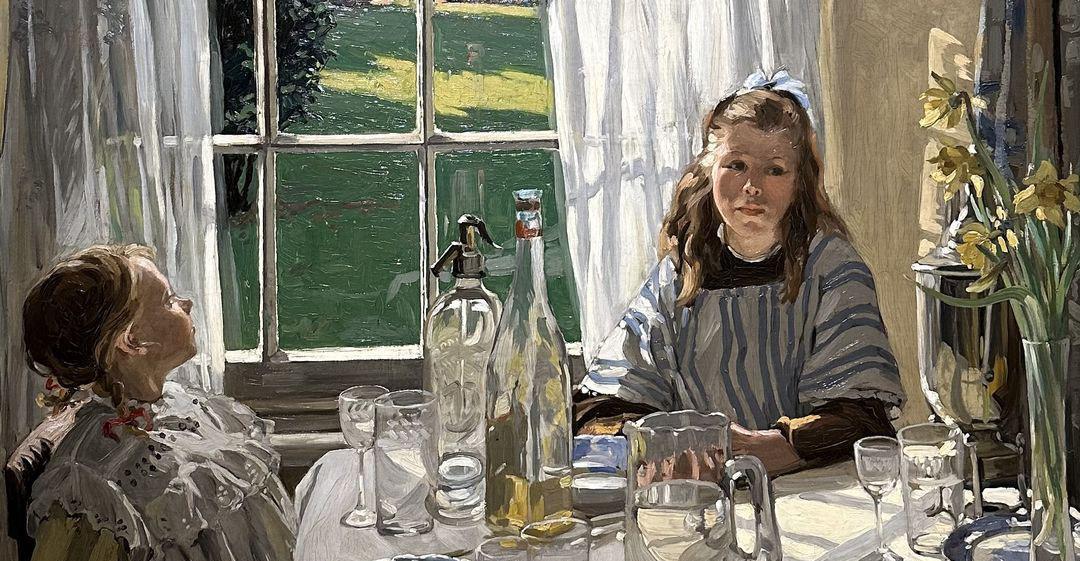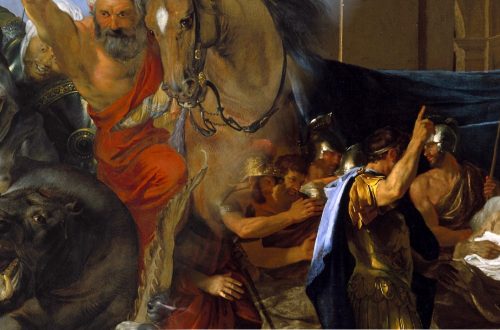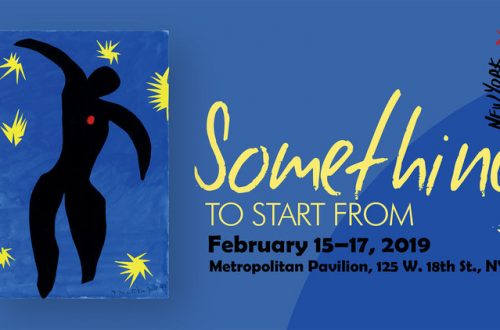by Andrew Carr
There’s an oil painting at the Minneapolis Institute of Art called Silver and Green. It was painted by Hilda Fearon in 1913. The painting is a pleasure. When you enter the room where it’s hanging, even before you fully register what the painting represents, the pleasure is already there, just as you turn the corner and see it on the wall. Something about the paint itself, the way it’s used and the shapes it makes, simply feels good. Your eye enjoys seeing it. The pleasure is already there from the beginning and it only deepens as you look.

What is this pleasure?
Fearon’s title points us toward the interplay of color. And the museum placard insists that light is the painter’s real preoccupation. But there’s something more central, I think. A sense of clarity that pervades the entire painting. Wherever you look the forms are distinct and carefully distinguished from each other. Nothing is hidden or obscure. Manet would have called the work sincere.
Take for example the sturdy glass pitcher on the table. Contained within its silhouette are a multitude of carefully calibrated color shapes—unified around the same honey-beige palette, but each with its own distinct identity. Look at the creamy wedges, like slices of brie cheese, just beneath the water’s elliptical surface. Or at the warm gray curves that radiate from the bottom of the pitcher’s thick handle like ripples spreading in a pool from a bright white pebble. Or the subtle, but not vague, squiggles describing the fluted rim.
Around each of these elements gather neighbors, with their own unique but related forms and tones. The individual character of each particular statement is never lost or diluted, even as it participates in the larger structure. The forms are not blended into each other or overworked, but placed alongside one another with confidence and seeming simplicity.
In his Oil Painting Techniques and Materials Harold Speed compares this type of clarity to “a long-sustained melody played on the violin, the quality of which depends on each note being held in great purity, and separateness, from each other note. Any scratchiness of tone or variety introduced will destroy the beauty of the melody.”
No one would called Silver and Green a scratchy painting. The notes are clear and pure. There’s never any ambiguity for the eye to overcome, never any uncertainty to confront. At a purely abstract level, this clarity, this easy apprehension of individual elements, makes the painting visually delicious. Like an orchard of ripe fruit ready to be plucked. The fruit fits perfectly into vision’s grasp. The eye feels confidant in reaching out—wonderfully matched to its environment.
And Fearon’s painting has the further pleasure of so economically and aptly assigning these unique touches of paint to the visual reality of her scene. Each statement feels like precisely what was needed to express its corner of the room. Like the dots on the younger girl’s frock, to notate the lace, here in black, there in a muted white. Or the trail of commas that run around the cups and glasses to suggest cut crystal. In each case the painted statement feels like just exactly what was called for.
At some level this “fitting” of statement to sensation, is analogous to the process of naming, of fitting words to reality. And if we extend the metaphor, we might say that Fearon is a painter with excellent diction. “Diction” both in the sense that she can find the perfect word for what she wants to describe— and in that she pronounces each word so well.
Silver and Green offers the pleasure of the articulate.
“As music is the poetry of sound, so painting is the poetry of sight,” writes Whistler. And given Fearon’s Whistleresque title, the two painters seem to agree. As the poet must weigh each word for its ability to deepen the nuance and richness of a line; as a composer must consider the interplay of each note or chord in a progression; so the painter must fine tune her colors and forms for a harmonious visual phrase.
But Whistler’s analogy is more than merely rhetorical. He saw in classical music a freedom from subject matter, and a reverence for structure and form, as values in their own right, that he longed to establish in painting. His titles—Symphony in White No. 1, Harmony in Pink and Grey, Arrangement in Grey and Black (as opposed to the colloquial Whistler’s Mother)—are an attempt to stake out that same aesthetic independence. In fact, what I’ve quoted above actually goes on to assert just such a claim: As music is the poetry of sound, so painting is the poetry of sight, and subject-matter has nothing to do with harmony of sound and color.
Turning again to Fearon’s Silver and Green, with Whistler’s words in mind, it’s remarkable how well the musical metaphor agrees with the painting, how easily the table, the dishes, the girls themselves, can be viewed essentially as the occasion, the excuse for the development and elaboration of pictorial themes.
Notice, for example, how Fearon arranges a piano key pattern of blue and white stripes where the light plays along the older sister’s shoulder. Then repeats the same melody, an octave down, where the sleeve turns into shadow and the notes are delivered in muted blue and cool gray. The theme is taken up again, legato this time, and at a slower tempo, in the long, thin, vertical strand of softer highlight running down the drape that hangs above the flowers—so that the girl’s outfit matches the drapery, just as the lace of her younger sister’s costume rhymes with the translucent folds of illuminated curtain behind her, integrating them both into the interior design like pieces of furniture.
But strangely enough, the girls themselves almost seem aware of this process taking place. And if Fearon is indeed absorbed in this “poetry of sight”—the children in her painting are not. They’re bored. If the painting is like a piece of music, then the girls are like students who have been taken to a somber, dim orchestra hall on a bright spring morning and told to sit quietly and listen to an exactingly performed string sonata. Their minds are elsewhere.
The younger girl in pigtails makes no attempt to conceal this impatience and cranes her neck to stare out of the window. Her older sister, either from a more completely instilled sense etiquette, or because her back is to the window, contents herself with the slender vase of daffodils on the table, whose yellow petals and long green stems stand there like a domesticated and aestheticized symbol of the bright spring day outside.
Indeed, although Fearon’s technique eschews visual ambiguity, another type of ambiguity arrives by way of her young sitters. Silver and Green certainly seems to depict boredom. The charming ambiguity arises around whether the painting initially set out to depict that boredom, or accidentally caused it along the way. Are the girls tired of a brunch that has dragged on too long, with being forced to sit and listen to the adults until they are excused? Or are they tired of posing as models for a painting?
Bored of being painted. Bored of sitting still while Fearon comes up with the “words” for everything. The more I look the more I think that they’re tired of being art. That they want to be children again.
Have you ever benefitted from boredom in a museum? Share your story in the comments below.
No matter what. Long before morning I knew that what I was seeking to discover was a thing I’d always know. That all courage is a form of constancy. That it was always himself that the coward abandoned first. After this all other betrayals came easily.
— in Cormac McCarthy’s, Sunset Limited
Interested in engaging with quotes like this more often? Click here to subscribe to our quote of the day, feature, “A Daily Dose of Veritas.”

Andrew Grum Carr is an artist, writer, and teacher from St. Paul MN. He writes short fiction and works in watercolor. He loves cinema, the library, and Saturday night jazz. You can find his artwork at www.andrewgrumcarr.com or follow him on Instagram @andrewgrumcarr.
header image: Silver and Green, Hilda Fearon, 1913 (detail)



